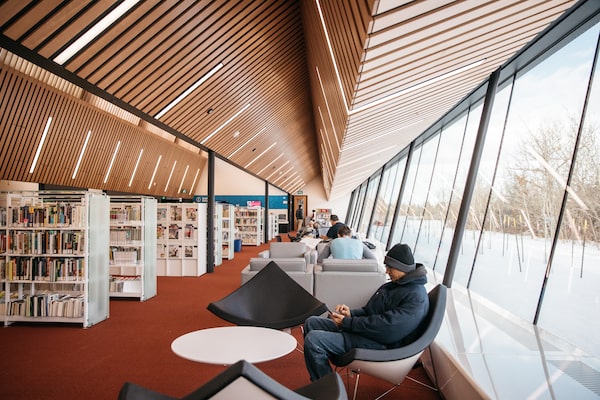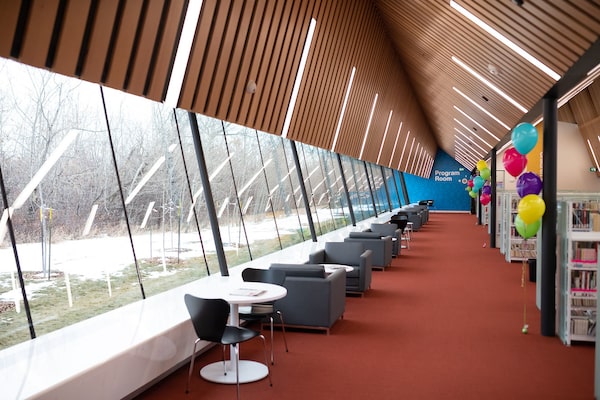
The Capilano branch of the Edmonton Public Library.Cooper & O'Hara/Supplied
The Toronto Public Library is planning a noteworthy building project: a new branch for the St. Lawrence neighbourhood downtown. At 30,000 square feet, this will be a major public facility in one of the most visited parts of the city.
It should be one of the country’s most significant architectural commissions of the decade. In Europe, it would be the subject of a design competition that would attract top talent from across the continent.
But that is not how things work in Toronto or in most of Canada. We don’t value public architecture, and we aren’t willing to pay for it.
That’s true even at the Toronto Public Library, the smartest and most ambitious public-sector organization in the city.
“We are committed to design excellence first and foremost,” said Moe Hosseini-Ara, the TPL’s director of branch operations and customer experience.
And yet recent history suggests the St. Lawrence branch will be designed by one of a few large architecture firms, which will accept a fee that is very low and then design the building under time pressure. That is no recipe for excellence.

In Edmonton, chief architect Carol Belanger has reformed procurement and actively sought out designers from across Canada and the world.Leroy Schulz/Supplied
Most major TPL projects in the past few years have had architecture fees around 7 per cent of construction cost, which industry sources agree is a difficult number. Nearly all have been designed by three architecture firms: Diamond Schmitt Architects, Perkins & Will Canada and LGA Architectural Partners.
Sometimes this works out well – as with LGA’s Scarborough Civic Centre branch, a beautiful building that moved the art of architecture forward with some playful use of mass timber.
But that opened in 2015. Since then, I have found little to celebrate in the libraries. Things are worse in Toronto’s parks department: the large Canoe Landing community centre, recently completed downtown, is an architectural flop. (And let’s not even discuss the public school boards.)
Civic leaders should be asking: Why isn’t there more competition for public architecture in Toronto? Nearly every thoughtful architect in the city would love to do a library. Yet the same few firms dominate projects at the library and in parks. The two largest recreational centres to be awarded in recent years have gone to Diamond and P&W. Each design, in turn, has faced harsh criticism from the city’s Design Review Panel.
Are those two firms the world’s best at designing public buildings? I don’t even think they are the best in Toronto.
The problem is procurement. It begins with a catch-22. The library, like most governmental organizations, wants architects to show they’ve recently designed three similar projects. If you haven’t done it already, you can’t do it. This approach shuts out new voices, and it is unnecessary.
Another issue is fee. The library’s 7-per-cent number is not sufficient. It amounts to $2.1-million on a $30-million building, and includes thousands of hours of consultation, design and construction supervision, along with the subcontracts of other consultants – including engineers. And it’s low enough that architects run the risk of losing money.
At the Bentway, ‘hip-hop architect’ Michael Ford explores the wisdom of the streets
The 2022 Governor General’s Medals show public sector architecture is not leading the way
Yet the work of these professionals will determine how the building works for many decades. In the long term, the costs of construction and maintenance are vastly larger than the design fee. Nickel-and-diming up front makes no sense.
There are other ways to hire. In Edmonton, chief architect Carol Belanger has reformed procurement and actively sought out designers from across Canada and the world. A recent branch was designed by Patkau Architects of Vancouver, which has a huge global reputation. It is fantastic.
Money is one factor, Mr. Belanger explains; in his city the architects’ fee is pegged to guidelines from a professional association. Architects can’t win by lowballing.
“We have found,” he said, “that you get what you pay for.” For a project such as the St. Lawrence library, the fee schedule puts the architects’ fees at between 9 and 10 per cent – as much as 40 per cent higher than the Toronto norm. And, Mr. Belanger said, the city routinely receives proposals from the country’s most highly regarded design firms.
Ultimately, why should civic officials care which architects they hire?
They have a responsibility to do so. Architecture – like its sister discipline landscape architecture – is a cultural product. Canada hasn’t encouraged the growth and innovation in these sectors. The result has been 30 years of underwhelming public spaces.
The larger answer is clear if you’ve seen ambitious public buildings in Quebec, or in Edmonton, or in New York City, where I recently visited a small library renovation in Brooklyn by the decorated architects WORK AC. It delivers comfortable kids and teens’ areas in a renovated factory crammed with interesting graphics, textiles and spatial ideas. Creamsicle-orange curved walls cradle the little kids’ zone, delivering the vibe of a cave on a friendly alien planet.
This is a building that holds books and keeps the rain out. But it also delivers a surfeit of architectural creativity. Could Toronto do that, too?
Mr. Hosseini-Ara says the library welcomes new voices. Let’s see, with the St. Lawrence project, whether they open the door.
Sign up for The Globe’s arts and lifestyle newsletters for more news, columns and advice in your inbox.